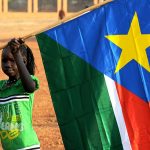The Tata Gonda religious movement, also known as the Celestial Army, is a unique religious community founded by the Congolese prophet Tata Gonda Wasilua. Emerging in 1989 in the Democratic Republic of Congo (DRC*), the movement blends elements of African traditional beliefs and Christianity. Tata Gonda, claiming to have received a divine call to humility and penitence, began wearing sackcloth – a rough material traditionally used for packaging goods – as a symbol of humiliation before God. This marked the beginning of the movement, whose followers emulate his austere lifestyle. Watch YouTube video on this religious movement.

Beliefs and Practices
The followers of Tata Gonda, primarily located in the DRC and Angola, adhere to a strict and monastic way of life aimed at opposing what they perceive as an unjust and sinful world. They believe in spiritual purification and humility, which they express through distinctive daily rituals and practices:
- Attire: Following Tata Gonda’s example, members exclusively wear garments made from sackcloth. This symbolizes their commitment to a life of humility before God.
- Hygiene Rituals: Instead of traditional bathing, community members perform a daily ritual of covering themselves with ashes, which they believe has antiseptic properties.
- Prohibitions: To maintain spiritual purity, they abstain from consuming alcohol, smoking, and wearing luxurious or fashionable items.
- Communal Living: The community lives in seclusion from mainstream society, maintaining self-sufficiency through activities like agriculture and fish farming. Their daily life is rooted in continuous prayer and communal harmony.

Community Structure and Leadership
After Tata Gonda’s death, the community continued under new leadership while adhering strictly to the teachings and principles established by their founder. They reside in Mbanza Nzambi (around 3 hours south of Kinshasa), the site of Tata Gonda’s original settlement. Governance within the community is autocratic, with decisions guided by the spiritual leader who upholds the founder’s vision.
Social Interaction and Outreach
Despite their secluded lifestyle, the Tata Gonda community is known for its hospitality toward visitors. Travelers often describe being warmly welcomed, sharing meals, and engaging in discussions that extend late into the night. This openness offers a rare glimpse into their distinct way of life, which some observers perceive as a unique form of communal living rather than a conventional religious sect.
Presence Beyond DRC and Angola
While the Tata Gonda sect has established communities in the DRC and Angola, there is no significant evidence suggesting the movement’s presence in the Republic of Congo (Congo-Brazzaville). The sect remains primarily rooted in DRC and Angola, maintaining its identity through a lifestyle deeply connected to the founder’s vision. [Geography 101: The area once known as the Congo is now represented by two main countries – the Democratic Republic of the Congo (DRC) and the Republic of the Congo (RC). RC is sometimes referred to as Congo-Brazzaville to distinguish it from the DRC, which is sometimes called Congo-Kinshasa. Belgian Congo (now the Democratic Republic of the Congo) and French Congo (now the Republic of the Congo) were colonies underBelgian and French rule respectively. DRC was known as Zaire during 1971-1997]. {Read: Why are there two Congos?}
Final Thoughts
The Celestial Army of Tata Gonda represents a profound blend of spirituality and communal living, where humility and separation from materialism form the core of religious practice. The movement’s commitment to simplicity, symbolic attire, and a life rooted in prayer reflects a radical interpretation of faith within the Central African context.
[You might be interested in reading about the Temple of All Religions, or syncretic religion of Cao Đài].
YPT Tours to Africa





